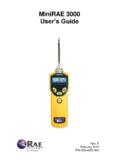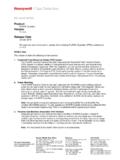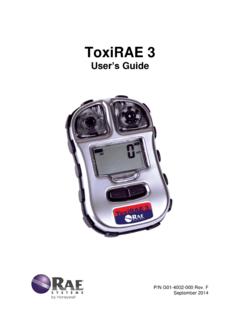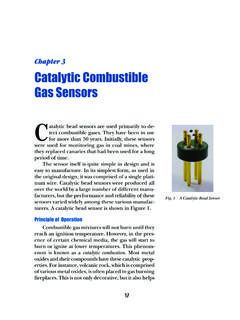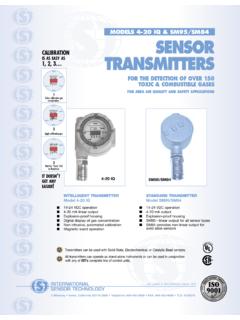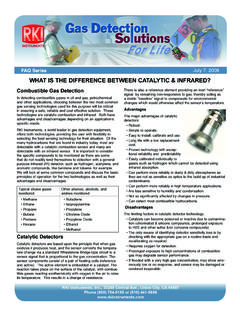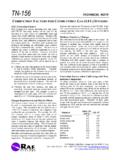Transcription of QRAE II User’s Guide - Wireless Gas Detectors, Gas ...
1 qrae II user s Guide Covers qrae II Diffusion & Pump Models with Firmware Version or higher P/N 020-4100-000 Rev. F May 2013 Copyright 2011 RAE Systems by Honeywell qrae II user Guide Page 1 Contents Read Before Operating .. 3 1 General Information .. 6 Key Features .. 6 Specifications .. 7 2 Charging The qrae II Battery .. 8 Low Voltage 9 Clock Battery .. 9 3 user Interface .. 10 user Interface Icons .. 10 Turning The qrae II On .. 11 Inverting The Display .. 13 Testing The Alarms (Anytime) .. 13 Pump Status ( qrae II Pump Only) .. 13 Turning The qrae II Off .. 14 4 Operating The qrae II .. 15 Mode Overview .. 15 Normal Mode .. 16 Diagnostic Mode .. 17 Adjusting The Pump Stall Threshold ( qrae Pump Only) .. 21 Adjust Pump Stall: High .. 21 Adjust Pump Stall: Low.
2 22 Programming Mode .. 24 Enter Programming Mode .. 25 Navigating Programming Mode .. 26 Calibrate Monitor .. 27 Change Alarm Limits .. 29 Change Datalog .. 32 Change Monitor Setup .. 36 Change Sensor Configuration .. 42 5 Alarm Signal Summary .. 45 6 Bump Testing & Calibrating The qrae II .. 46 Connecting the Calibration Gas To The Monitor (Pump Model Only) .. 46 Connecting The Calibration Adapter (Diffusion Model Only).. 47 Disconnecting The Calibration Adapter (Diffusion Model Only) .. 48 Zero (Fresh Air) Calibration .. 49 Using Fresh Air .. 49 Using Zero Gas .. 49 Multiple Sensor Calibration .. 50 Single Sensor Calibration .. 51 7 Connecting To A Computer .. 53 8 Transferring Data To & From A Computer .. 53 Downloading The Datalog To A PC .. 53 Uploading Firmware To The qrae II From A PC .. 54 qrae II user Guide Page 2 9 Maintenance.
3 55 Replacing the qrae II Li-Ion Battery .. 55 Installing The Alkaline Battery Adapter .. 56 Charging A Spare qrae II Li-Ion Battery .. 57 Replacing Sensors .. 58 Sensor Locations .. 58 Replacing The Filter .. 60 Replacing The Pump ( qrae II Pump Model Only) .. 60 Cleaning .. 62 Firmware Updates .. 63 Ordering Replacement Parts .. 63 Electronic Waste Disposal .. 63 Year of Manufacture .. 63 10 Troubleshooting .. 64 11 Technical Support .. 65 12 RAE Systems Contacts .. 66 13 Controlled Part of Manual .. 68 qrae II user Guide Page 3 WARNINGS Read Before Operating This manual must be carefully read by all individuals who have or will have the responsibility of using, maintaining, or servicing this product. The product will perform as designed only if it is used, maintained, and serviced in accordance with the manufacturer s instructions. CAUTION!
4 Never operate the monitor when the cover is removed. Remove the monitor cover and battery only in an area known to be non-hazardous. Note: Users are recommended to refer to ISA , Part II-1987 for general information on installation, operation, and maintenance of combustible gas detection instruments. Warranty Registration Register your warranty online by visiting: This ensures that your qrae II is registered and ensures that we can let you know of important updates. qrae II user Guide Page 4 WARNINGS Use only RAE Systems rechargeable battery pack part number 020-3402-000, or alkaline battery pack part number 020-3403-000. Use only DURACELL MN1500 batteries with alkaline battery pack. This instrument has not been tested in an explosive gas/air atmosphere having an oxygen concentration greater than 21%. Substitution of components may impair suitability for intrinsic safety.
5 Recharge batteries only in non-hazardous locations. Do not connect the serial communication port in a hazardous location. STATIC HAZARD: Clean only with a damp cloth. For safety reasons this equipment must be operated and serviced by qualified personnel only. Read and understand instruction manual completely before operating or servicing. All newly purchased RAE Systems instruments should be bump tested by exposing the sensor(s) to known concentrations of calibration gas. The monitor should be calibrated if it does not pass a bump test, but no less than every 6 months, depending on use and exposure to gas and contamination, and its operational mode. Bump test is defined as an exposure to gas that triggers the lowest alarm. Calibration intervals and bump test procedures may vary due to national legislation. When using the qrae II with an H2S sensor, RAE Systems recommends using RAE calibration gas cylinders with a 4-gas mix containing 10 ppm H2S, 50 ppm CO, 50% LEL Methane, and 18% Oxygen.
6 Any rapid up-scale reading followed by a declining or erratic reading may indicate a gas concentration beyond upper scale limit which may be hazardous.. qrae II user Guide Page 5 AVERTISSEMENT Utiliser seulement l'ensemble de batterie RAE Systems, la r f rence 020-3403-000. Utiliser uniquement des piles alcalines modele DURACELL MN1500 avec l adaptateur piles alcalines Cet instrument n a pas t test dans une atmosph re de gaz/air explosive ayant une concentration d oxyg ne plus lev e que 21%. La substitution de composants peut compromettre la s curit intrins que. Ne charger les batteries que dans un emplacement d sign non dangereux. Ne reliez pas le port de communication s rie dans un endroit dangereux. RISQUE D'ORIGINE ELECTROSTATIQUE: Nettoyer uniquement avec un chiffon humide. Pour des raisons de s curit , cet quipement doit tre utilis et entretenu uniquement par un personnel qualifi.
7 Tudier le manuel d instructions en entier avant d utiliser, ou d entretenir l quipement. Tout appareil neuf de RAE Systems doit pr alablement passer le test de v rification d talonnage qui consiste exposer le ou les capteurs a une concentration connue de gaz talon. Le d tecteur doit tre imp rativement talonn s il ne passe pas le test de v rification d talonnage, ou bien au moins tous les 6 mois, selon l utilisation et l exposition a des gaz poisons ou des contaminants, et selon le mode op ratoire. Une v rification d talonnage est d finie par une exposition du d tecteur au gaz d talonnage qui doit d clencher le seuil d alarmes bas. - RAE Systems recommande d utiliser les bouteilles d talonnage RAE Systems avec un m lange des quatre gaz suivant 10 ppm H2S, 50 ppm CO, 50% LIE m thane, et 18% d oxyg ne. - Toute variation de la lecture rapide et positive, suivie d une baisse subite ou erratique de la valeur, peut indiquer une concentration de gaz hors gamme de d tection qui peut tre dangereuse.
8 qrae II user Guide Page 6 1 General Information qrae II is a programmable multi-gas monitor, available in pumped and diffusion models, designed to provide continuous exposure monitoring of oxygen, hydrogen sulfide, carbon monoxide and combustible gases for workers in hazardous environments. It monitors with the following types of sensors: 1. Combustible gases are monitored with catalytic bead sensors. 2. Hydrogen sulfide (or sulfur dioxide) and carbon monoxide are monitored with electrochemical sensors. 3. Oxygen is monitored with a solid polymer electrolyte (SPE) sensor. Key Features Lightweight and Compact 9 oz (250 g) diffusion model, 12 oz (350 g), pump version, handheld size. Dependable and Accurate qrae II diffusion model: 14 hours of monitoring with microcontroller. qrae II Pump model: minimum 10 hours on Li-Ion battery, and 8 hours on alkaline battery user Friendly Menu-driven, intuitive end-use operation.
9 Programmable Alarm Thresholds Audio buzzer and flashing display alarm. Standard configuration includes CO, H2S, LEL, and O2 sensors Replaceable, rechargeable Li-Ion battery Large, easy-to-read display Datalogging with large memory Visual alarm with bright red flashing LEDs Loud audible alarm (95dB at 30 cm) Vibration alarm Rugged weather-resistant composite case Diffusion model and pump model qrae II user Guide Page 7 Specifications qrae II Specifications Configuration Pumped or diffusion 4-gas with datalogging Dimensions: Diffusion: 5" L x " W x " H (125mm x 72mm x 38mm) Pump: 5" L x " W x " H (125mm x 72mm x 38mm) Weight: Diffusion: 9 oz (250g) Pump: 12 oz (350 g) with battery Detectors: 2 Electrochemical toxic gases sensors 1 Solid Polymer Electrolyte oxygen sensor 1 Catalytic sensor for combustible level organics Battery: Rechargeable Li-ion battery pack (6-hour charge time) or a 3 AA alkaline battery adapter.
10 Operating Time: Up to 10 hours continuous w/ Li-ion battery pack Display: 4-line graphical LCD with automatic LED backlight for dim lighting conditions Keypad: 2 programming/operation keys Direct Readout: Up to 4 simultaneous values with sensor name, battery charge, high and low values for all sensors, elapsed time, and datalogging on/off state Sampling Method: Diffusion or pumped (depending on model) Range, Resolution & Response Time: LEL 0-100% 1 % 15 sec O2 0-30% % 20 sec CO 0-1000 ppm 1 ppm 25 sec H2S 0-100 ppm ppm 30 sec Alarm Settings: Separate limits for TWA, STEL, High, Low Alarms: >95 dB @ 30 cm buzzer, flashing red LEDs, vibration alarm, LCD to indicate exceeded preset limits, low battery, or sensor failure Calibration: Two-point field calibration for fresh air and standard reference gas Protection: Password protected calibration settings, alarm limits, and data Intrinsic Safety: CSA Class I, Division 1, Group A, B, C, D, T4 (US & Canada), SIRA ATEX II 2G Ex ia d II C T4 Gb (Europe), IECEx Ex d ia II C T4 Gb EM Immunity: No effect when exposed to RF interference (5-watt transmitter at 12"/10cm).
